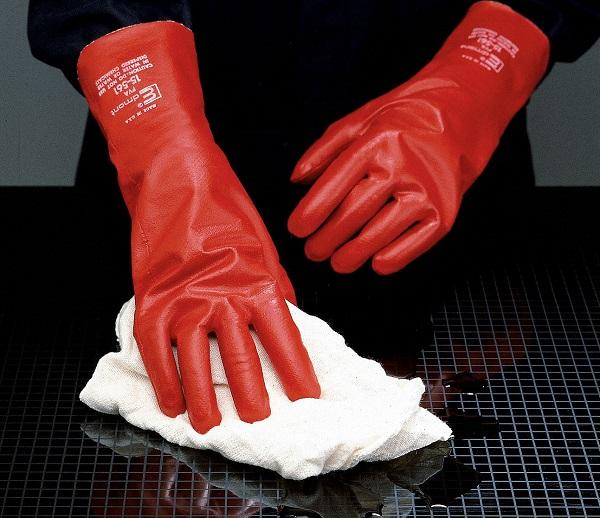When it comes to protecting your hands on the job, choosing the right chemical resistant glove is crucial. Whether you’re working in a laboratory, manufacturing plant, or other industrial setting, the right glove can make all the difference in keeping your hands safe and healthy. Not only can improper glove use lead to skin irritation and chemical burns, but it can also result in long-term health issues such as cancer and reproductive harm. Skin exposure to hazardous substances in the workplace is an issue that plagues the United States. OSHA statistics from 2018 reveal 25,000 cases of skin disease at a rate of 2.2 per 10,000 employees – surpassing even respiratory illnesses which only recorded 19,600 with a rate of 1.7 injuries per 10,000 workers! By implementing safer practices and protective measures we can ensure healthier working environments for our communities now and into the future.
Here’s how to select the appropriate chemical resistant glove for your needs. It is important to note that while some gloves may provide protection against certain chemicals, they may not provide protection against others. It is also important to consider the chemical’s concentration as it can affect the level of protection needed. For example, a glove that provides protection against a chemical at a certain concentration may not provide the same level of protection at a higher concentration. It is also important to consider the chemical’s physical state when selecting gloves. For example, gloves that are suitable for protecting against liquid chemicals may not be suitable for protecting against gases or vapors.
As the use of chemicals continues to increase in various industries, it is imperative to prioritize safety and make informed decisions when selecting chemical resistant gloves. This guide will provide the necessary steps to properly identify the chemicals you’ll be working with, consider the duration of exposure, evaluate the glove’s physical characteristics, and check for certifications and standards to ensure the best protection for your hands. Remember that glove selection is just one part of a larger safety program, and it is important to have an overall understanding of how to safely handle chemicals in the workplace. It’s also important to keep in mind that gloves alone may not provide enough protection, and should be used in conjunction with other safety measures such as eye and face protection, ventilation, and proper disposal of chemicals. Always consult the manufacturer’s chemical resistance chart and the safety data sheet (SDS) for the chemicals you will be working with, and consult with safety professionals if you have any doubts or questions about selecting the appropriate chemical resistant gloves for your job.
Step 1: Identify the chemicals you’ll be working with. The first step in selecting a chemical resistant glove is to identify the specific chemicals you’ll be working with. Different types of gloves provide varying levels of protection against different chemicals, so it’s essential to know exactly what you’ll be dealing with. Make a list of the chemicals you’ll be working with and their concentrations, and consult the manufacturer’s chemical resistance chart for guidance on which gloves will provide the best protection. It is important to note that while some gloves may provide protection against certain chemicals, they may not provide protection against others. It is also important to consider the chemical’s concentration as it can affect the level of protection needed. For example, a glove that provides protection against a chemical at a certain concentration may not provide the same level of protection at a higher concentration. It is also important to consider the chemical’s physical state when selecting gloves. For example, gloves that are suitable for protecting against liquid chemicals may not be suitable for protecting against gases or vapors. It is important to consult the manufacturer’s chemical resistance chart for guidance on the appropriate gloves for your specific chemicals.
Step 2: Consider the duration of exposure. Another important factor to consider is the duration of exposure to the chemicals. If you’ll be working with the chemicals for an extended period, you’ll need a glove that can provide long-term protection. In contrast, if you’ll only be working with the chemicals for a short period, a disposable glove may be sufficient. It is important to keep in mind that disposable gloves are not meant for long-term use and should be replaced frequently to ensure protection. It is also important to consider the frequency of contact with the chemicals. For example, if you’ll be frequently handling the chemicals throughout the day, a glove that can withstand multiple uses and provide long-term protection is necessary. On the other hand, if contact with the chemicals is infrequent, a disposable glove may be sufficient.
Step 3: Evaluate the glove’s physical characteristics. When evaluating chemical resistant gloves, it’s essential to consider the glove’s physical characteristics, such as its thickness and flexibility. A thicker glove will provide better protection but may be less comfortable to wear and make it harder to perform tasks that require fine motor skills. A more flexible glove will be more comfortable to wear but may not provide as much protection. It is important to find a balance between protection and comfort. It is also important to consider the glove’s dexterity and grip. Some gloves may have a rough texture that provides a better grip, while others may have a smooth texture for fine motor tasks. It is important to choose a glove that will provide the appropriate level of dexterity for the task at hand.
Step 4: Check for certifications and standards. Finally, it’s essential to check for certifications and standards when selecting a chemical resistant glove. Look for gloves that have been tested and certified by organizations such as OSHA, ASTM, and EN. These certifications ensure that the gloves have been tested and meet specific performance standards for chemical resistance. It is important to note that not all chemical resistant gloves have been tested or certified, and choosing a certified glove is important to ensure that the glove has been tested and meets specific performance standards. It is also important to check the expiration date on the gloves. Some gloves have a shelf life and may lose their effectiveness after a certain period of time. It is important to check the expiration date and replace the gloves if necessary to ensure ongoing protection.
Selecting the right chemical resistant glove is essential to ensure the safety and health of your hands while working with chemicals. By identifying the chemicals you’ll be working with, considering the duration of exposure, evaluating the posure, evaluating the glove’s physical characteristics, and checking for certifications and standards, you can make an informed decision and choose the best chemical resistant glove for your needs. Remember that glove selection is just one part of a larger safety program, and it is important to have an overall understanding of how to safely handle chemicals in the workplace. It’s also important to keep in mind that gloves alone may not provide enough protection, and should be used in conjunction with other safety measures such as eye and face protection, ventilation, and proper disposal of chemicals. Always consult the manufacturer’s chemical resistance chart and the safety data sheet (SDS) for the chemicals you will be working with, and consult with safety professionals if you have any doubts or questions about selecting the appropriate chemical resistant gloves for your job.
References:










